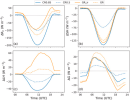Wang Zhikai
New member
Dear all WRF users,
I have a question regarding the WRF output variable CM_AC_URB3D, which is described as "CONSUMPTION OF THE AIR COND" in the Registry.EM_COMMON.
The unit for this variable is given as "W m⁻²". I would like to confirm how this area-averaged value is calculated. Specifically, does this value represent:
Best regards,
Zhikai
I have a question regarding the WRF output variable CM_AC_URB3D, which is described as "CONSUMPTION OF THE AIR COND" in the Registry.EM_COMMON.
The unit for this variable is given as "W m⁻²". I would like to confirm how this area-averaged value is calculated. Specifically, does this value represent:
- The air conditioning energy consumption averaged over the entire grid cell area?
- Or, is it the energy consumption averaged only over the building footprint area within that grid cell?
Best regards,
Zhikai


